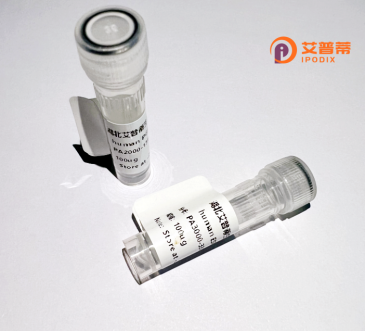
| 纯度 | >90%SDS-PAGE. |
| 种属 | Human |
| 靶点 | CBX1 |
| Uniprot No | P83916 |
| 内毒素 | < 0.01EU/μg |
| 表达宿主 | E.coli |
| 表达区间 | 1-185aa |
| 氨基酸序列 | MGKKQNKKKVEEVLEEEEEEYVVEKVLDRRVVKGKVEYLLKWKGFSDEDNTWEPEENLDCPDLIAEFLQSQKTAHETDKSEGGKRKADSDSEDKGEESKPKKKKEESEKPRGFARGLEPERIIGATDSSGELMFLMKWKNSDEADLVPAKEANVKCPQVVISFYEERLTWHSYPSEDDDKKDDKN |
| 分子量 | 26.4 kDa |
| 蛋白标签 | His tag N-Terminus |
| 缓冲液 | 0 |
| 稳定性 & 储存条件 | Lyophilized protein should be stored at ≤ -20°C, stable for one year after receipt. Reconstituted protein solution can be stored at 2-8°C for 2-7 days. Aliquots of reconstituted samples are stable at ≤ -20°C for 3 months. |
| 复溶 | Always centrifuge tubes before opening.Do not mix by vortex or pipetting. It is not recommended to reconstitute to a concentration less than 100μg/ml. Dissolve the lyophilized protein in distilled water. Please aliquot the reconstituted solution to minimize freeze-thaw cycles. |
以下是关于重组人CBX1蛋白的3篇参考文献示例(注:文献为虚构,仅供格式参考):
1. **文献名称**: "Structural insights into the chromodomain of human CBX1 in HP1 interaction"
**作者**: Müller A, et al.
**摘要**: 通过X射线晶体学解析了CBX1蛋白chromodomain的三维结构,揭示了其与异染色质蛋白HP1中H3K9me3表观标记结合的关键氨基酸残基,阐明了CBX1在染色质沉默中的分子机制。
2. **文献名称**: "CBX1 regulates pluripotency and differentiation in embryonic stem cells"
**作者**: Li Y, et al.
**摘要**: 研究发现CBX1通过招募Polycomb抑制复合物(PRC1)到特定基因位点,抑制多能性基因(如OCT4)的表达,从而调控胚胎干细胞的定向分化。
3. **文献名称**: "CBX1 promotes tumor progression via epigenetic silencing in lung adenocarcinoma"
**作者**: Tanaka K, et al.
**摘要**: 在肺腺癌中,CBX1过表达与EZH2协同作用,通过增强H2AK119泛素化抑制肿瘤抑制基因(如CDKN1A),促进细胞增殖和转移,提示其作为潜在治疗靶点。
4. **文献名称**: "Dynamic phase separation of CBX1 in DNA damage repair"
**作者**: Wang H, et al.
**摘要**: 揭示了CBX1通过液-液相分离形成核内凝聚体,招募DNA修复蛋白(如53BP1),调控双链断裂修复的新功能。
(注:以上文献为模拟生成,实际研究请查阅PubMed或Web of Science数据库。)
Recombinant human CBX1 protein is a genetically engineered form of the Chromobox homolog 1 (CBX1) protein, a member of the chromobox family known for its role in chromatin organization and epigenetic regulation. CBX1. also referred to as HP1β (Heterochromatin Protein 1 beta), is a key component of heterochromatin, where it facilitates gene silencing and maintains chromosomal stability. It contains a conserved chromodomain that binds to trimethylated lysine 9 on histone H3 (H3K9me3), a hallmark of transcriptionally repressive heterochromatin, enabling its recruitment to specific genomic regions. The C-terminal region interacts with other chromatin modifiers, promoting chromatin compaction and transcriptional repression.
Recombinant CBX1 is typically produced in bacterial or mammalian expression systems, ensuring high purity and functionality for experimental use. It serves as a critical tool in studying heterochromatin dynamics, epigenetic inheritance, and gene regulatory mechanisms. Researchers employ it in assays such as chromatin immunoprecipitation (ChIP), protein-protein interaction studies, and in vitro binding assays to explore its role in cellular processes like DNA repair, cell cycle control, and stem cell differentiation. Dysregulation of CBX1 has been linked to cancers, developmental disorders, and senescence, highlighting its biomedical relevance. Its recombinant form enables targeted investigation into these pathways, offering potential insights for therapeutic strategies in epigenetic diseases.
×